When coating carbon-fibre components for premium cars, flawless cosmetic finishes and excellent corrosion and weathering resistance are vital. This challenge recently prompted Novation Tech, one of Europe’s leading manufacturers of carbon fibre and composite components, to install a new coating plant. For this ambitious project, it turned to a pool of leading companies in the industrial coating sector: Linea Eco Air for designing and installing the plant, SE.PO. for the conveyor, and CMA Robotics for robotic application equipment.
In the last few years, the automotive sector has been witnessing the increasing adoption of advanced materials such as carbon fibre and composite materials. These are especially valued for their outstanding mechanical properties, such as lightness, tensile strength, and stiffness. The reduction in overall vehicle weight achieved by using them contributes to improved performance and energy efficiency and also reduces CO2 emissions, making cars more environmentally friendly.
However, the coating of carbon fibre components poses a unique challenge in the automotive industry, as the surface treatment of composite materials calls for specific processes to ensure optimal paint adhesion and long-lasting protection against external agents. Unlike traditional metals, carbon fibre composites require meticulous surface preparation, which may include cleaning, sanding, and the application of special primers to ensure optimal adhesion of the coating. Finishing quality and aesthetics are also fundamental prerequisites, especially for parts intended for high-end cars – such as those handled by Novation Tech, a leading carbon fibre and composite component manufacturer.
“To meet the high aesthetic standards of premium car manufacturers, finishes must be flawless, free of defects such as microbubbles, and perfectly uniform. Aiming at successfully meeting these challenges, Novation Tech has entrusted Linea Eco Air (Sona, Verona, Italy) with the installation of a new coating system that will enable us to improve process control, guarantee superior finishing quality, and increase production efficiency,” says Beatrice Buziol, Novation Tech’s Sustainability and Marketing Manager.
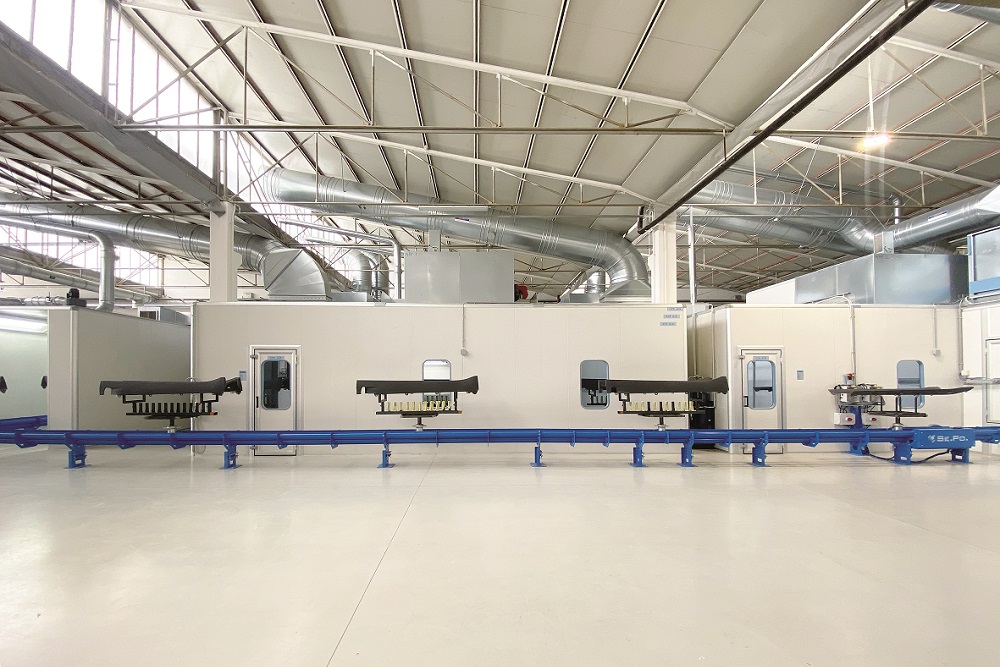 Overview of the coating system supplied by Linea Eco Air. © ipcm
Overview of the coating system supplied by Linea Eco Air. © ipcmAbout Novation Tech
Founded in 1967 in Montebelluna, in the province of Treviso (Italy), Novation Tech started out in the metal moulding sector and later specialised in special alloy machining and plastic injection. “2007 marked a significant turning point in our company’s history. After developing and installing several state-of-the-art production technologies, we created the first carbon fibre backrest for sports cars. This success prompted us to invest further in new processes and improved technologies, as well as enabling it to reach new markets: in 2011, we opened a production site in Hungary, and in 2019, we started construction of a plant in Croatia, operational since 2020,” states Beatrice Buziol.
“The automotive industry is our core business, accounting for 92% of our turnover. The production of components for the aerospace and sports & leisure sectors accounts for the remaining 8%,” explains Gabriele Tiveron, Key Account Automotive at Novation Tech. The technological expansion continued in 2021 with the opening of a new, fully integrated department for manufacturing components in various materials using four different 3D printing technologies. In mid-2022, the company also renovated two factories in Trevignano (Treviso), achieving the same production capabilities as the Montebelluna site and creating an advanced robotics hub, as well as installing the Group’s first complete coating line.
Today, Novation Tech employs more than 1400 people across 5 locations and is one of Europe’s leading manufacturers of carbon fibre and composite components for a variety of industries. “Constant R&D activity and technological innovation, combined with streamlined production management, have enabled Novation Tech to become a reliable partner for the world’s biggest automotive brands, able to quickly meet market needs and always offer top-notch products,” emphasises Tiveron.
The production process of carbon fibre components
“Since 2007, Novation Tech has been a supplier of various car elements for major automotive groups – seats, interior and structural components, body parts, and so on. Their production process is highly specialised and accurate as the automotive industry is extremely demanding and regards high quality and precision as top priorities,” notes Tiveron.
Novation Tech’s manufacturing cycle starts with developing a master model and preparing a pre-preg material kit. These are followed by lamination, i.e. the manual positioning of carbon fibre layers on the mould, a delicate phase that requires great care and expertise. The parts are then placed inside the autoclave, the heart of Novation Tech’s production process. Inside it, the components undergo a polymerisation cycle lasting 4 hours at 140 °C and 6 bars. That ensures even pressure and temperature distribution, vital for the correct polymerisation of carbon fibre materials and the production of top-quality components.
After polymerisation, the carbon parts are removed from the mould using special equipment, and each workpiece is carefully inspected and checked for compliance with its drawing. “The process continues with milling, where the parts are placed on a template and finished with extreme precision, and glueing with any plastic or metal parts, if required by the project specifications. Before coating, the parts undergo a mechanical pre-treatment that includes sanding, sandblasting, and thorough cleaning to remove release agents and residues deposited during the previous processes. Glueing and sanding can be done manually or by a robot to ensure perfect adhesion of the different parts and consistent surface preparation,” explains Tiveron.
The coating cycle and the new line’s technical characteristics
Novation Tech’s new coating system, installed by Linea Eco Air, was designed to paint car exterior components such as skirts, bonnets, and bumpers. The cycle begins with a deionisation phase that removes dust particles and residues deposited during previous stages through air jets. The components then enter the manual primer application booth and, subsequently, the flash-off area, where they are heated at 40 °C for about 25 minutes.
“This booth has a suction wall to ensure the airflow is horizontal and the operator is never hit by overspray. In addition, to ensure safe operation, we have installed a foot pedal that allows each workpiece to be moved to its optimal position and locked before application. Until the workpiece – usually with a length of over 2 metres – is brought back to its initial position, the conveyor does not move to prevent it from colliding with the line’s components,” illustrates Gianfranco Soliani, the owner of Linea Eco Air.
The following two coating booths, devoted respectively to applying the first clear coat layer and a coloured or a second clear coat layer depending on customer specifications, are equipped with an articulated robot model
GR 6150 HW supplied by CMA Robotics
(Pavia di Udine, Udine, Italy). Painting products are supplied by Vernici Caldart
(Cagnano, VI) and PPG (Quattordio, AL).
“These two automatic booths are also devised to ensure maximum operator safety, thanks to an alarm system that automatically stops the robot if someone accidentally accesses them. In addition, pneumatic doors avoid any risk of contamination between one area and another,” says Soliani.
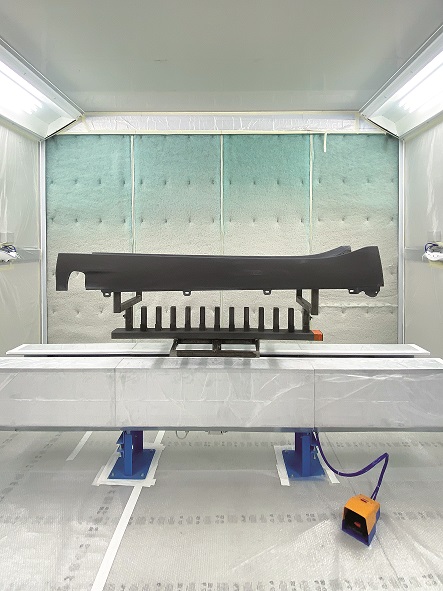 The primer application booth is equipped with a suction wall and a foot pedal to move each workpiece to the optimal position for the operator. © ipcm
The primer application booth is equipped with a suction wall and a foot pedal to move each workpiece to the optimal position for the operator. © ipcm“The robot offers great flexibility of use thanks to the special configuration of its hollow wrist, which makes it easy to reach every surface area by rotating each axis more than 360°. For programming the work cycles, a point-to-point system is used, consisting of detecting and processing some geometrically relevant points on the surface to be coated by special software. Corrections can be made at any time to points, speed rates, connections, and process parameters. The programmes are stored and managed by a computer integrated into the control desk, and they are sorted by alphanumeric codes on Compact Flash storage devices. They can be selected manually with a standard keyboard, with a quick search system, or automatically through remote control,” explains CMA Robotics’ Sales Manager, Marco Zanor.
“Between the two application booths is another flash-off station heated by natural gas generators with an air stream burner. Finally, after the application of the second coat, the components enter the baking oven, where they dwell for about 45-50 minutes, and then the forced cooling area, where we use air taken from outside to reduce their surface temperatures so that the operator can easily handle them in the unloading phase,” says Soliani.
“The plant is equipped with an inverted monorail conveyor featuring a trolley with four weight-bearing wheels. This compact configuration allows handling parts while maintaining a high level of stability of the conveyor, both during transport along the track and during rotation and coating in the booth., which could create defects in the coating layers,” indicates Marco Pozzi, the owner of SE.PO. (Olginate, Lecco, Italy).
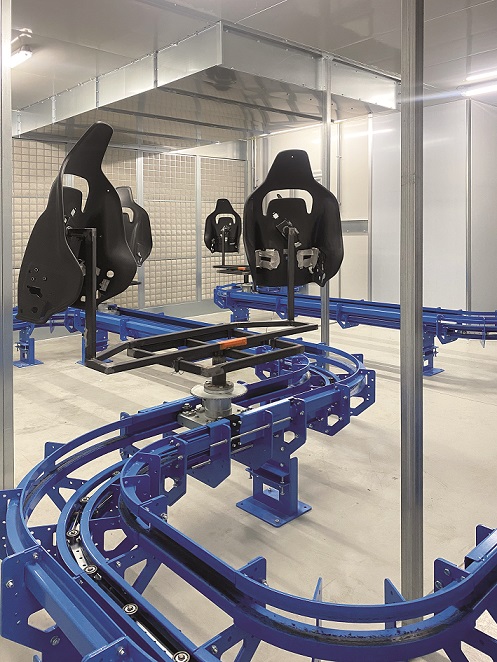 The plant is equipped with an inverted monorail conveyor designed by SE.PO., featuring a trolley with four weight-bearing wheels. © ipcm
The plant is equipped with an inverted monorail conveyor designed by SE.PO., featuring a trolley with four weight-bearing wheels. © ipcm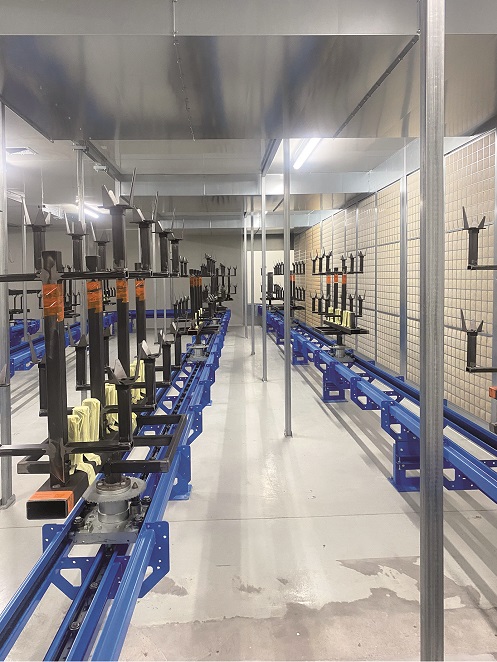 Components inside the drying oven. © ipcm
Components inside the drying oven. © ipcmReasons behind this choice
The new coating line was conceived to meet the company’s need for a guaranteed coating cycle time and number of treated parts. That is why Novation Tech opted for a step-by-step system, unlike most automotive plants built with a continuous-flow conveyor. “We initially agreed that our ideal takt time was 5 minutes, but we soon realised that with this system, we could reduce it even further, thus improving performance. In addition, a step-by-step system ensures greater consistency and precision in coating,” adds Tiveron.
The new line was also designed to ensure meticulous process control, which is essential to finish exterior components that must meet strict aesthetic and functional parameters, as well as having excellent corrosion and weathering resistance properties. “In the high-end automotive industry, the finishing of components is of crucial importance. The level of quality required by our customers is extremely high since we work with leading high-end car manufacturers,” emphasises Tiveron.
Novation Tech reworks about 20% of its coated components, confirming the importance of its finishes’ appearance. “At the beginning of a project, we agree with the customer on so-called “quality books”, which define the maximum number of acceptable defects, such as microdots and microinclusions. If the defects exceed that number, the part is sanded and re-painted. At the end of the coating cycle, the components are inspected under special light tunnels where the operators check the uniformity of the paintwork, which must be free of defects such as vibration-related issues or holograms. We also subject them to rigorous mechanical and ageing tests, such as climate, salt spray resistance, and water immersion tests.”
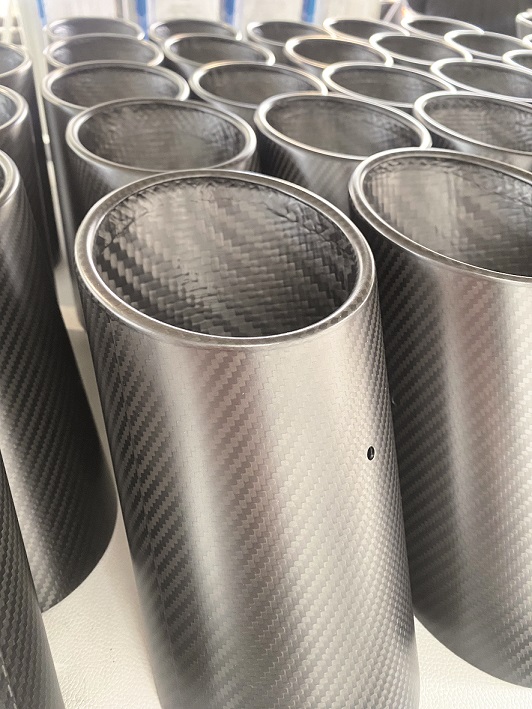 Some painted car exhaust caps. © ipcm
Some painted car exhaust caps. © ipcmSustainability as an added value
Novation Tech has always been committed to sustainability and environmental protection. In 2023, it took a significant step forward in this area by investing in photovoltaic systems for its plants in Italy and Hungary to reduce energy consumption and carbon footprint. Such a focus on sustainability is also evident in the design choices made for the new coating plant. “We decided to use an air stream burner instead of one with a combustion chamber because this solution significantly reduces fuel consumption. Air stream burners do not have a combustion chamber or a flue-gas stack, which allows recirculating all energy within the system and only using exhaust fans to maintain a healthy environment. In addition, we have installed rotating bells on the robots to reduce emissions by 30-40% and improve paint consumption efficiency through electrostatic technology. These choices clearly demonstrate our commitment to promoting more sustainable and environmentally friendly production practices,” notes Buziol.
A successful partnership
“We decided to install this new coating plant because we needed to equip our factory with an articulate and advanced production structure as a key to improving the aesthetic and functional quality of our products’ finishes. The limited space in our facilities had always prevented us from setting up a complete coating system, forcing us to use body shop booths. However, with the increasing production volumes and the need to solve some quality issues such as bubbling and cissing, we took the opportunity to equip ourselves with a suitable line when we acquired the new factory in Trevignano.
“This new space has allowed us to install an automated system ensuring strict control of all process stages. We turned to Linea Eco Air, with which we had already collaborated in the past and of which we appreciated the expertise in the finishing sector. Its collaboration was fundamental, as we defined and designed every detail of the system together. In this company, we have found an attentive partner capable of understanding and meeting all our needs. Its technical team proved to have great knowledge of coating processes, helping us approach a field we knew only superficially and guiding us in every decision. Results to date include higher finishing quality and greater control over our end products’ quality. With the plant soon to be fully operational, we also anticipate a significant increase in productivity, which will further strengthen our ability to meet any market demand,” concludes Tiveron.